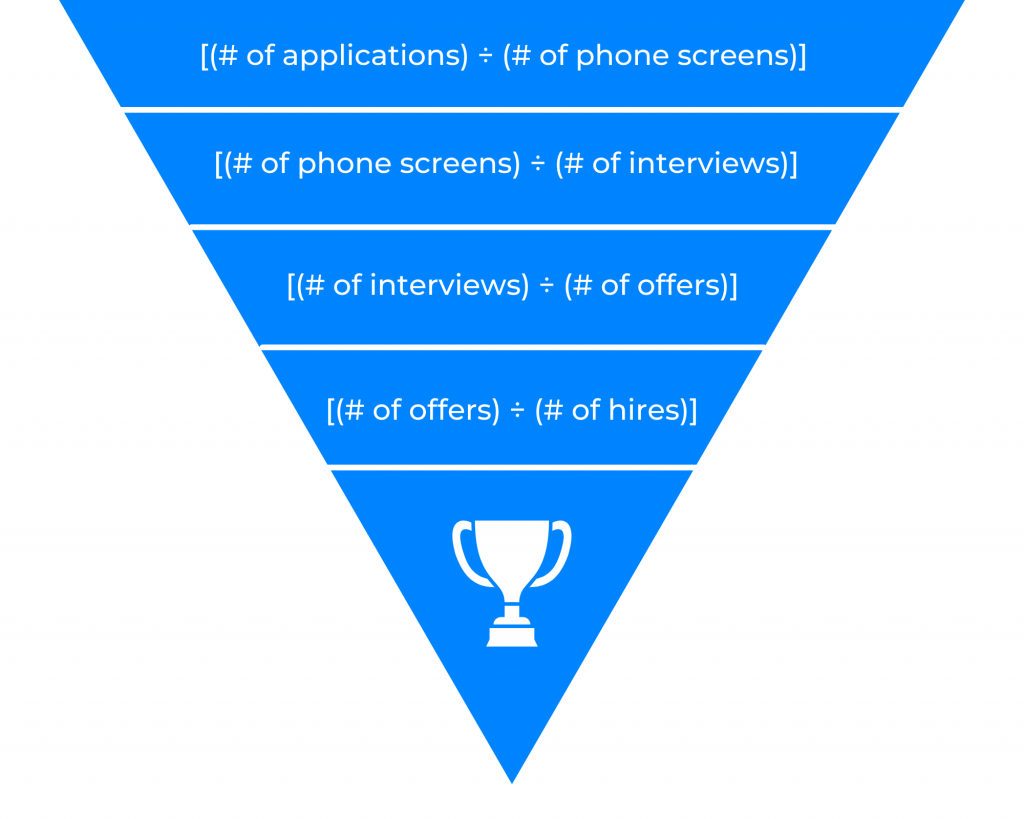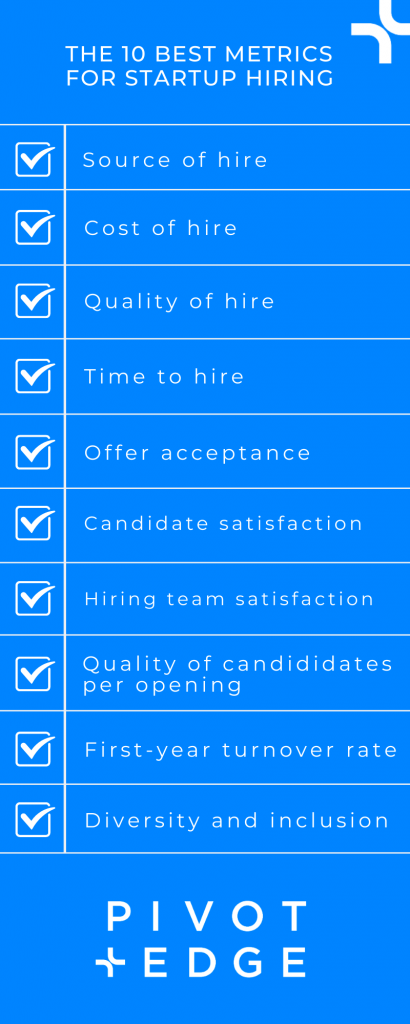How to Hire Fast and Reduce Turnover with Data-Focused Recruitment Marketing techniques
You’d think hiring is all about the person-to-person dynamic, but hiring can be a massive headache and resource strain for any startup. However, there are many data-driven measures you should take to hire more strategically for your business. You need to divert manpower to screening, interviewing, hiring, and onboarding talent on top of investing in measures to keep your new hires happy. Strategically hiring the best people for your business is crucial to avoid turnover and will ensure your people scale up as your business does. To start hiring the right people as effectively as possible, you should include two things into your strategy: KPIs (key performance indicators) and metrics. Are you missing either of these two steps? With today’s technology, tracking the methods that work — and don’t work — have gotten even easier when you know where to look. Don’t brush off these critical aspects for ensuring a successful startup; find out how to hire effectively and strategically using KPIs and metrics and save your business both time and money.
KPIs & Metrics:
In short, KPIs are metrics that inform how close or far your startup is from achieving its goals. As any determined goal-setter knows, a great plan is actionable and measurable. KPIs are the missing piece as far as specific measurement goes. They are the time-sensitive, company-specific metrics you’ll use to stay on track with your goals. A general metric is something that tracks a process, such as website clicks. They’re essential for the overall monitoring of how your systems are working. If you find you monitor a certain metric day-in and day-out, you may want to consider making it into a KPI for your goals. In turn, a KPI measures your actual business goal: Ad click-to-job application conversions over a month. For hiring, what you measure will depend on your overall objectives. However, there are a few common places to start. Depending on how the KPIs measure up, you can make informed decisions on where your hiring strategy needs to improve. Here are 10 of the best metrics to consider when developing KPIs in your new data-driven hiring approach:
Source of hire
Analyzing the sources of your candidate pool tells you where the startup has had success finding a) the most candidates and b) the best ones. This is important as it helps inform how to optimize advertising for future hiring. If an area is underperforming, cut it and allocate those funds to other aspects of the startup. Your source of hire will also indicate where to find certain kinds of talent. You may notice trends like finding a younger demographic of applicants through Instagram versus established professionals in their fields through LinkedIn. Knowing how to effectively find and target ideal candidates for different roles will save a lot of time and money.
“A general rule of thumb is that you should be spending somewhere between 16 and 20 per cent of the employee’s starting annual salary on their hire.”
Cost of hire
Money matters, especially for a startup. The cost per hire is a significant metric for most hiring strategies. Cost includes job postings, paychecks issued for hours spent interviewing, potential agency fees, job fairs, recruitment bonuses, and more. The math behind it is relatively simple: Total hiring costs divided by the number of employees hired. A general rule of thumb is that you should be spending somewhere between 16 and 20 per cent of the employee’s starting annual salary on their hire, according to Workopolis. The more entry-level the position, the closer to the low end of that range you should target. Overspending per hire could mean your hiring strategy is ineffective and needs a revamp. It could also mean you need to take a deeper look at some other metrics to see where you can make cuts and where your startup hiring could be more efficient.
Quality of hire
Are you finding the right people for your open positions? Analyzing the quality of hire will let you know whether or not the people you bring into the company bring value along with them. As My Ally puts it, “High-performing candidates are indicative of hiring success (and vice versa), but[…] a single bad hire can cost a company thousands of dollars.” How do you know if you’ve brought in a quality candidate? It’s a little more complicated than measuring whether or not they’re bringing in money. You’ll need to merge retention/promotion rates with recruitment data and employee engagement surveys. While quality can be a challenging assessment to make, it has the bonus of shining light on the future performance of potential hires based on their characteristics and how they interview.
Time to hire
As cliche as it is, time really is money. Analyze how long candidates spend in each part of the recruitment process to discover roadblocks and bottlenecks that kill your rates. With such a competitive hiring market, the more quickly you can screen and get a job offer on the table, the more likely you are to lock in that top talent.
Medium has listed the following ratios as the top areas to improve your hiring time:
- days from application to phone screen,
- days from phone screen to interview,
- days from interview to offer, and
- days from offer to hire.
Acceptance rates
Have you found fantastic candidates but keep losing them at the offer? This could be a huge red flag for your hiring strategy. If you primarily receive rejection letters, you may need to analyze how your team goes about recruiting or the way your startup presents its culture to potential hires. Another crucial analysis that goes hand-in-hand with acceptance rates is the loss analysis. If you rejected a candidate or they turned you down, where did they go on to work? The same applies to turnover. Looking at where talent moves to will help determine your competition and what they may be doing differently to win over top talent.
“…Highly engaged employees show 21% greater profitability.”
Candidate satisfaction
More and more, businesses recognize that success doesn’t just depend on customer satisfaction but also employee satisfaction. In fact, Forbes claims that highly engaged employees show 21% more profitability. Satisfied candidates won’t just accept offers; they’ll apply to other roles within your company or try to bring in like-minded people, saving you time and money recruiting. How do you gauge candidate satisfaction? Send out a quick survey after the interview process is complete. You can hire a third-party research company to handle this step for you, or there are simple-to-use online platforms you can use to bang these out yourself, such as SurveyMonkey or Typeform..
Recruitment team satisfaction
Checking in with your hiring manager and recruitment team is as vital as checking on your candidate’s satisfaction. It will help determine whether they feel the hiring criteria are accurate for bringing in the best candidates and indicate which process could be improved. It’s another easy metric to check on — send out a quick survey asking about improvements and their experience during the hiring round or pop in for a short debrief.
Qualified candidates per opening
Measuring the qualified candidates that apply to each job opening informs your startup of two things: whether you’re advertising in the right places and if your job descriptions are written effectively enough to attract ideal candidates. You might be asking: “What is considered quality?” There are several areas you can determine this metric depending on how stringent of a measure you want. “Qualified” can mean the candidate moved past the first stage of the hiring process—or that they received a job offer.
First-year turnover rate
Turnover is a money killer for any business but especially startups, where cash might be tight. It can let you know whether you’re hiring the wrong people or have a larger problem with the overall company culture, which means employees don’t want to stay. It could also mean you’re setting unrealistic job expectations or need to address your onboarding process.
“…make sure you have leadership that is actively investing in diverse talent and supporting their promotion and advancement opportunities.”
Diversity and Inclusion
Now more than ever, companies are looking to diversify their workforce. Keeping track of gender ratios and ethnicity is a good start. But for your diversity and inclusion training programs to have any real impact, you need to make sure you have leadership that is actively investing in diverse talent and supporting their promotion and advancement opportunities. Otherwise your startup or scaleup is going to appear male, pale and stale – not a good look in 2021.
Given diversity and inclusion are increasingly being debated and discussed in the latest generation of talent moving into the workforce, Pivot + Edge did a deep dive Q&A with Laura McGee, Founder of workplace diversity analytics platform, Diversio. The timely and poignant conversation calls out the systemic roadblocks to diversity and inclusion and breaks down why better inclusion attracts better employees and make better money. Be sure to encompass these factors in your employer branding and overall workplace culture.
Forecasting
Analytics are fantastic for a retroactive look at how your scale-up hires. They can also be a great way to forecast your business’ tracking in terms of its quarterly hiring plan. To do this, businesses compare their funnel analytics to time-to-hire, job openings and hiring goals. Funnel analytics take a peek at where candidates are dropping off during the recruitment process. The top of your funnel is the initial application site. Not enough applicants at the top of the funnel mean there’s likely an issue with where you’re promoting or how you’re wording your job descriptions. Not enough applicants moving forward means you’re missing out on finding quality candidates. Not enough offer acceptances for each offer mean you’re losing talent due to competition or internal factors, and so on. Keep in mind, if you have 10 people reaching a second stage interview, it might be time to refine what you want so that only the best fits get through.
Once you have the raw data for how many candidates you have at each stage and you’re ready to see how your process is performing, compare the ratios of candidates moving between stages for a single job posting to identify strong and weak points as you go down your funnel. Here’s an example of a funnel analytics calculation from Medium:

By looking at the four forecasting components, you’ll discover where to rally your teams around the hiring process. From there, you’ll be able to ensure you’re finding, hiring, and keeping top talent to grow with your startup.
Why scale-ups care about KPIs
Creating a hiring strategy is excellent, but you’ll be losing money on turnover without proper execution. Tracking your hiring goals by using the above metrics to build your KPIs means you’ll create an effective strategy and be successful in hitting your startup’s goals in a strategic, data-driven way. Revisit your metrics vigilantly and monitor your KPIs to have your startup manage its growth in terms of hiring. If it sounds overwhelming to do it all, check out various applicant tracking softwares, or leave it to the pros by considering hiring a professional recruitment marketing team like Pivot + Edge. For a more in-depth take on what you can do to hire your target candidates faster and better, head on over to our resources page and check out The Ultimate Guide to Hiring Great People For Your Startup.








